Class Mammalia
Order Rodentia
Family Geomyidae
Thomomys sp—Western Pocket Gophers // Thomomys bottae—Botta's Pocket Gopher // Thomomys bottae/umbrinus—Botta's or Southern Pocket Gopher // Thomomys gidleyi—Gidley's Pocket Gopher // Thomomys talpoides—Northern Pocket Gopher // Thomomys umbrinus—Southern Pocket Gopher
Three species of Thomomys currently occur in our region. Thomomys umbrinus (Southern Pocket Gopher) is limited to montane habitats in the extreme southwestern part of New Mexico and southeastern Arizona. Two species are apparent in the Pleistocene fossil record. Thomomys talpoides currently is a form occurring in the highlands of the northern parts of the region. Thomomys bottae now occurs at lower elevations in the north and also throughout the region south of T. talpoides. Skull differences are shown in Fig. 1.
In T. bottae, the infraorbital foramina are relatively farther anterior (anterior to the incisive foramina); in T. talpoides, the infraorbital foramina are more posterior (more or less even or posterior to the incisive foramina) and the entrance region is more narrowly depressed. The sphenoidal fissure in T. bottae is open; in T. talpoides, it is closed.
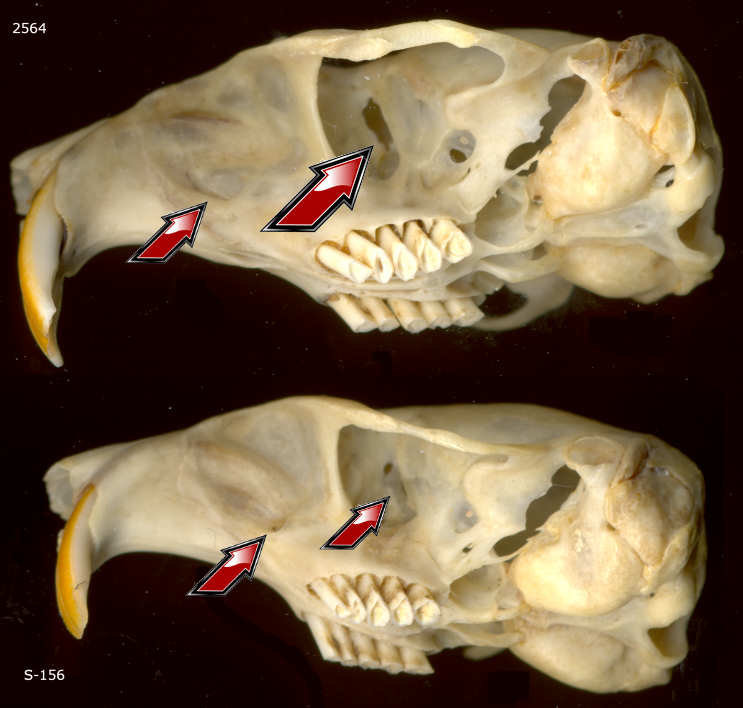
Fig. 1. Skulls of Thomomys bottae (top) and Thomomys talpoides. The left arrows point to the infraorbital foramen, the right arrow to the sphenoidal fissure area.
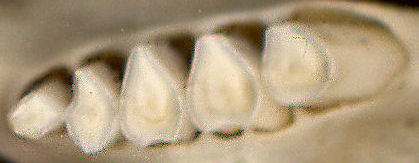
In the lower dentition, the anterior portion of p4 is asymmetrical in T. talpoides, and the lateral side of lower molars 1 and 2 are indented less strongly than in T. bottae (Fig. 2).
Fig. 2. Lower left dentition of Thomomys bottae.
Generally speaking, the dentary of T. bottae is more rugged than that of T. talpoides. Especially useful in discrimination is the nature of the angular process (rectangular in T. bottae, but with rounded anterior end resulting in a rounded point posteriorly in T. talpoides, Fig. 3). Also useful is the greater development of a ridge dorsal to the mandibular foramen in T. bottae compared to that of T. talpoides (Fig. 4).
Fig. 3 (left). Difference in the shape of the angular process of T. bottae
versus T. talpoides.
Fig. 4. Typical differences between T. bottae and T. talpoides in the
development of the ridge dorsal to the mandibular foramen."
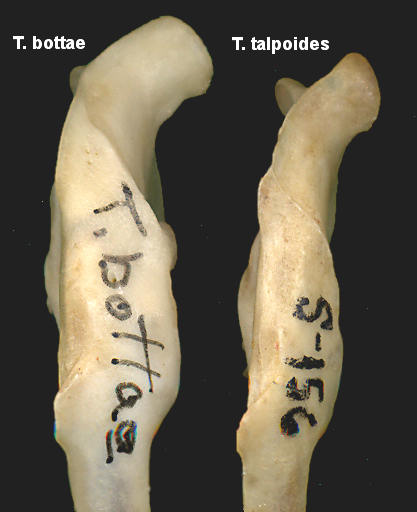
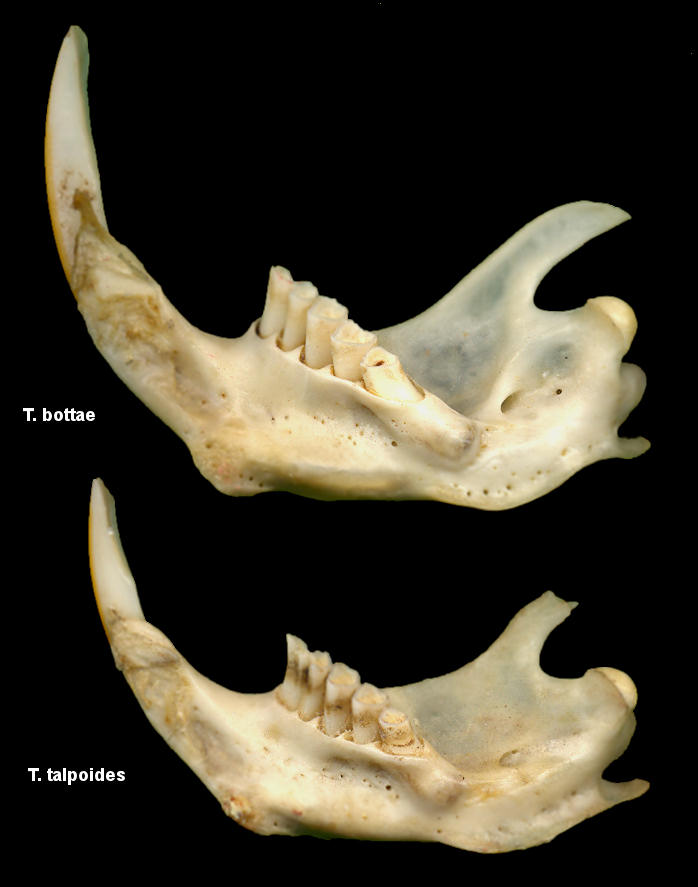
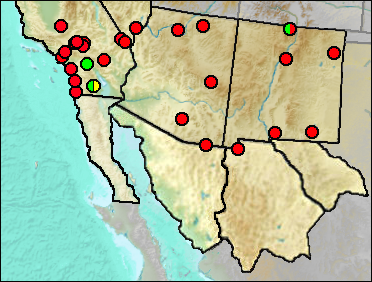
Specimens often are identifiable as Thomomys, but lack characteristics necessary to determine the species.
Sites.
Late Blancan/Irvingtonian: Anza-Borrego (Murray 2008).
Early Irvingtonian: El Casco, San Timoteo Badlands (Albright 2000)
Medial Irvingtonian: SAM Cave (Rogers et al. 2000).
Rancholabrean: Bitter Springs Playa (Jefferson 2014: Cf.); Campbell Hill (Jefferson 1991b); Chino Hills (Jefferson 2014); Cool Water Coal Gasification Solid Waste Site (Jefferson 1991b); Eagle Crest (Jefferson 2014); Hawes (Jefferson 2014); Helendale (Jefferson 1991b); Hoffman Road (Jefferson 2014); Morena Blvd. (Jefferson 1991b); National City West (Jefferson 2014); Park La Brea A (Jefferson 2014); Piute Valley (Jefferson 1991b); Tramperos Creek (Morgan and Lucas 2005); New La Bajada Hill (Stearns 1942); Pit Stop Quarry (Murray et al. 2005); Wilshire Blvd., 10580 The Wilshire, Los Angeles (Jefferson 1991b).
Late Pleistocene: Wanis View (Jefferson 2014).
Sangamon: Naval Fuel Reserve Quarry (Jefferson 1991b); Union Oil 76 Refinery no. 2, Los Angeles Harbor Yard, San Pedro (Jefferson 1991b); U. S. Veterans Hospital, Long Beach (Jefferson 1991b).
Mid Wisconsin: Shonto (Mead et al. 2005).
Mid/Late Wisconsin: Rampart Cave (Lindsay and Tessman 1974); Tsuma Properties, San Clemente (Jefferson 2014); .
Late Wisconsin: Bida Cave (Mead et al. 2005); Murray Springs (Mead et al. 2005); Rocky Arroyo No. 1 (UTEP); U-Bar Cave 13-14 ka (Harris 1989); Valley Wells (Springer et al. 2010); Wolcott Peak (Mead et al. 2005).
Late Wisconsin/Holocene: Conkling Cavern (Conkling 1932); SAM Cave (Rogers et al. 2000); Schuiling Cave (Jefferson 1991b).
Rancholabrean/Holocene: Arvin Landfill (Jefferson 2014: ?).
Literature. Albright 2000; Conkling 1932; Harris 1989; Jefferson 1991b, 2014; Lindsay and Tessman 1974; Mead et al. 2005; Morgan and Lucas 2005; Murray 2008; Murray et al. 2005; Rogers et al. 2000; Springer et al. 2010; Stearns 1942.
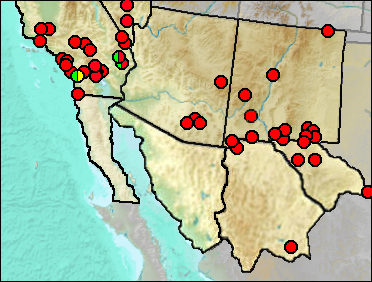
Synonyms. Thomomys fulvus pervagus; Thomomys umbrinus.
Botta's Pocket Gopher now occurs throughout the lowlands of the region and, south of the limits of the Northern Pocket Gopher, into the high mountains. Occurrences of the two species in the same fossil faunas may represent either presence of suitable habitat for both (e.g., north-facing slopes versus south-facing slopes) or tension zones where relatively rapid variations in climate sweep first one species and then the other into the collection zone.
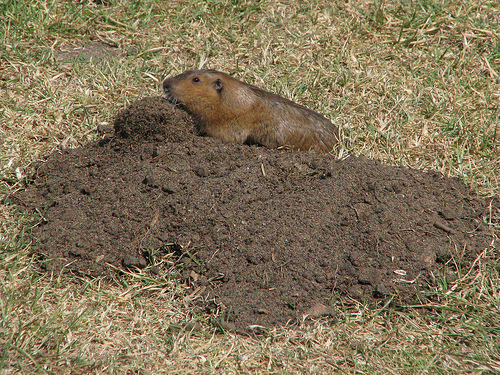
Fig. 1. Thomomys bottae just having pushed a load of soil from its underground burrow. Photograph by stonebird under Creative Common licence (Attribution-NonCommercial-ShareAlike 2.0 Generic (CC BY-NC-SA 2.0).
Fig. 2. Left p4 of Thomomys bottae. The nearly symmetrical shape of the anterior loph is typical.
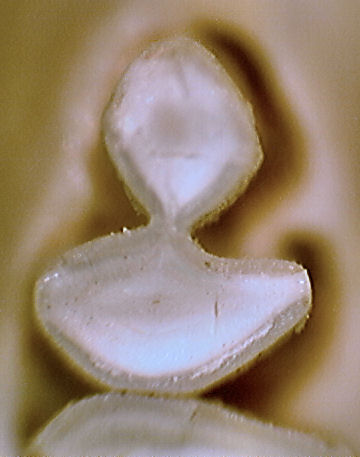
Sites.
Late Blancan/Early Irvingtonian: Elsinore: Mimomys (Pajak et al. 1996).
Irvingtonian: Elsinore: Microtus/Mammuthus (Pajak et al. 1996).
Late Irvingtonian: Elsinore: Pauba Formation (Pajak et al. 1996).
?Irvingtonian/Rancholabrean: Archer (Jefferson 2014); Cadiz (Jefferson 2014); Emery Borrow Pit (Jefferson 1991b).
Rancholabrean: Bedford Properties (Jefferson 1991b); Centennial Parkway (Jefferson et al. 2015); Century Blvd. and Van Ness Ave. (Jefferson 1991b); Century City, Los Angeles (Jefferson 1991b); Detention Basin (Jefferson et al. 2015); Harbor Freeway and 112-113th streets (Jefferson 1991b; cf.); Lake View Hot Springs (Jefferson 2014); Las Vegas Wash, Big Wash (Jefferson et al. 2015); Los Angeles Police Station (Jefferson 1991b); Outfall Sewer, Culver City (Jefferson 1991b); Palomas Creek Cave (Harris 1993c);Piute Ponds (Jefferson 2014).
Rancholabrean/Early Holocene: Metro Rail Universal City Station (Jefferson 2014).
Sangamon: Naval Housing Unit (Jefferson 1991b); Newport Bay Mesa (Jefferson 1991b); San Pedro Lumber Co. (Jefferson 1991a).
Wisconsin: Carpinteria (Wilson 1933: cf.); Costeau Pit (Jefferson 1991b); Glen Abbey (Majors 1993: cf.).
Early/Early-Mid Wisconsin: Lost Valley (Harris 1993c); Rm Vanishing Floor (Harris 1993c); Sabertooth Camel Maze (Harris 1993c).
Mid Wisconsin: McKittrick (Schultz 1937); Pacific City (Wake and Roeder 2009); Pendejo Cave (Harris 2003); U-Bar Cave (Harris 1987).
Mid/Late Wisconsin: Dark Canyon Cave (Tebedge 1988); Diamond Valley (Springer et al. 2009); NW Talus Slope (Harris 1993c); Pintwater Cave (Hockett 2000); Pit N & W Animal Fair (Harris 1993c); Rancho La Brea (Stock and Harris 1992.
Mid/Late Wisconsin/Holocene: Jimenez Cave (Messing 1986); Sierra Diablo Cave (UTEP).
Late Wisconsin: Algerita Blossom Cave (Harris 1993c); Animal Fair 18-20 ka (Harris 1989); Antelope Cave (Reynolds, Reynolds, Bell, and Pitzer 1991); Big Manhole Cave (Harris 1993c); Bison Chamber (Harris 1970); Camel Room (Harris 1993c); Charlies Parlor (Harris 1989); Corn Creek Packrat Midden (Jefferson et al. 2015); Cueva Quebrada (Lundelius 1984); Dust Cave (Harris and Hearst 2012); Folsom (Morgan and Lucas 2005); Harris' Pocket (Harris 1970); Human Corridor (Harris 1993c); La Mirada (Jefferson 1991b); Lower Sloth Cave (Logan 1983: cf. gen. et sp.); Maricopa (Jefferson 1991b); Mountain View Country Club (Jefferson 2014); Muskox Cave (Logan 1981: cf.); Navar Ranch (Van Devender et al. 1987: cf.); Pendejo Cave (Harris 2003); Picacho Peak (Mead et al. 2005: cf.); Stalag 17 (Harris 1993c: cf.); TT II (Harris 1993c); Tucson Mountains (Mead et al. 1983); U-Bar Cave 14-15 ka (Harris 1989); U-Bar Cave 15-18 ka (Harris 1989: cf.); U-Bar Cave 18-20 ka (Harris 1989); Upper Sloth Cave (Logan and Black 1979).
Late Wisconsin/Holocene: Balcony Room (Harris 1993c); Baldy Peak Cave (Harris 1993c); Bat Cave (Scarbrough 1986); Burnet Cave (Schultz and Howard 1935); Calico Lakes (Jefferson 1991b); Conkling Cavern (Harris 1993c); Deadman Cave (Mead et al. 1984: cf.); Fowlkes Cave (Dalquest and Stangl 1984b); Howell's Ridge Cave (Harris 1993c); Isleta Cave No. 2 (Harris 1993c); Kokoweef Cave (Reynolds, Reynolds, et al. 1991); Luz Foundation (Jefferson 1991b); Luz Solar Foundation (Jefferson 1991b); Newberry Cave (Jefferson 1991b); Pendejo Cave (Harris 2003); Solar One (Jefferson 1991b); Tule Springs (Springer et al. 2005: ?); Wolcott Peak (Mead et al. 2005).
Holocene: Isleta Cave No. 1 (Harris 1993c), withdrawn as a Pleistocene record.
Literature. Dalquest and Stangl 1984b; Harris 1970a, 1987, 1989, 1993c, 2003; Harris and Hearst 2012; Hockett 2000; Jefferson 1991b, 2014; Jefferson et al. 2015; Logan 1981, 1983; Logan and Black 1979; Lundelius 1984; Mead et al. 1983; Mead et al. 1984; Mead et al. 2005; Messing 1986; Morgan and Lucas 2005; Pajak et al. 1996; Reynolds, Reynolds, et al. 1991; Reynolds, Reynolds, Bell, and Pitzer 1991; Scarbrough 1986Schultz 1937; Schultz and Howard 1935; Springer et al. 2005, 2009; Stock and Harris 1992; Tebedge 1988; Van Devender et al. 1987; Wake and Roeder 2009; Wilson 1933.
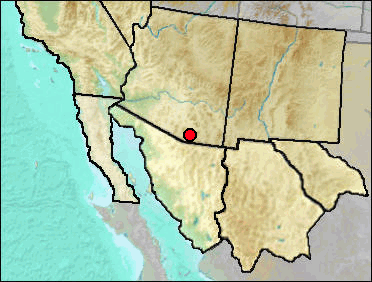
The Southern Pocket Gopher is similar to Botta's, and where either might be expected, identification on most elements is problematical. The former currently is primarily Mexican, extending into the northern Madrean mountains of southwestern New Mexico and southeastern Arizona
Sites.
Mid Wisconsin: Papago Springs Cave (Czaplewski and Mead et al. 1999).
Literature. Czaplewski and Mead et al. 1999.
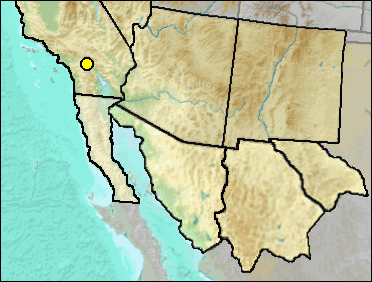
Sites.
Late Blancan: Jack Rabbit Trail, San Timoteo Badlands (Albright 2000).
Literature. Albright 2000.
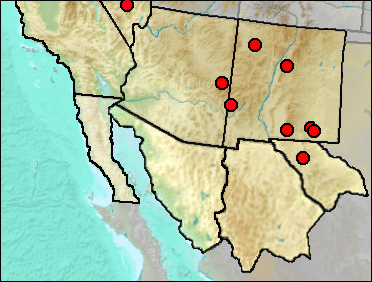
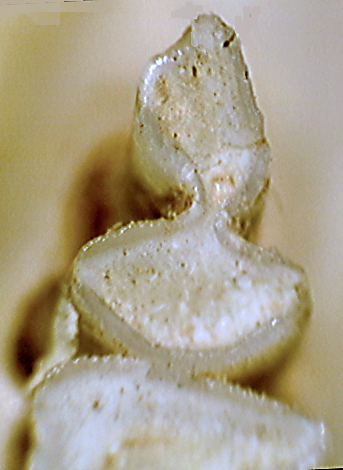 This species is a highlands species in Arizona and New Mexico,
but farther north occurs also in the intermontane basins.
This species is a highlands species in Arizona and New Mexico,
but farther north occurs also in the intermontane basins.
Fig. 1. Left p4 of Thomomys talpoides showing the typically asymmetrical anterior loph. Compare to Fig. 1 of the Thomomys bottae account.
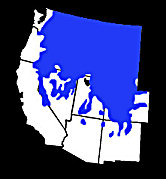
Fig. 2. Approximate current geographic range of the Northern Pocket Gopher. Adapted from Verts and Carraway (1999).
Sites.
Mid Wisconsin: Pendejo Cave (Harris 2003).
Mid/Late Wisconsin: Dark Canyon Cave (Harris 1993c); Pintwater Cave (Hockett 2000).
Mid/Late Wisconsin/Holocene: Sierra Diablo Cave (UTEP).
Late Wisconsin: Algerita Blossom Cave (Harris 1993c); Animal Fair 18-20 ka (Harris 1989); Balcony Room (UTEP); Bison Chamber (Harris 1970a); Camel Room (Harris 1993c); Dust Cave (Harris and Hearst 2012: cf.); Harris' Pocket (Harris 1970a); Human Corridor (Harris 1993c); Marmot Cave (Thompson and Morgan 2001); Pendejo Cave (Harris 2003); Sandia Cave (Thompson and Morgan 2001); Sheep Camp Shelter (Gillespie 1985); TT II (Harris 1993c).
Literature. Gillespie 1985; Harris 1970a, 1989, 1993c, 2003; Harris and Hearst 2012; Hockett 2000; Thompson and Morgan 2001; Verts and Carraway 1999.
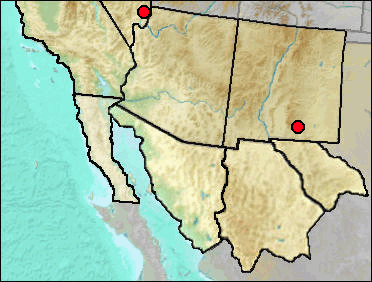
Synonyms. Thomomys fulvus intermedius.
Schultz and Howard (1935) reported this taxon based on three dentaries and an anterior skull. The wording gives rise to the suspicion that small size was the criterion used in the identification. Currently, the Southern Pocket Gopher occurs in the mountains of southwestern New Mexico and adjacent Arizona and then south into Mexico. The identification probably is erroneous, but cannot be ignored.
The Glendale, Nevada, specimen likewise likely represents T. bottae.
Sites.
Glendale (Jefferson et al. 2015).
Late Wisconsin/Holocene: Burnet Cave (Schultz and Howard 1935).
Literature. Jefferson et al. 2015; Schultz and Howard 1935.
Last Update: 7 Jan 2016